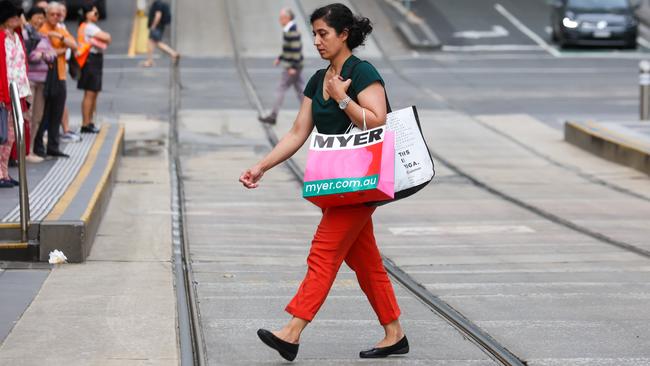Next RBA rate move down after retail sales plunge in December
Another interest rate hike looks even less likely, economists say, after tumbling retail spending in December confirmed households remained under intense pressure at the end of last year.

Another interest rate hike looks even less likely, economists say, after tumbling retail spending in December confirmed households remained under intense pressure at the end of the year.
Retail trade plunged by a larger than expected 2.7 per cent last month, as shoppers returned to their shells after splurging through November’s Black Friday sales. The figures come ahead of a crucial inflation report on Wednesday that is expected to show annual consumer price growth fell sharply to 4.2 per cent in the December quarter, from 5.4 per cent in September, as the economy labours under the weight of 13 interest rate rises and intense cost-of-living pressures.
Australia’s welcome disinflation through 2023 is part of a global trend that has allowed central banks around the world to signal interest rate cuts are on the way.
The International Monetary Fund in its latest update to the world economic outlook said the inflation crisis for most countries was now in the rear-view mirror, as it upgraded Australia’s growth forecast by 0.2 percentage points to 1.4 per cent in 2024.
Despite the more positive tone, Jim Chalmers said the IMF report highlighted the global growth outlook remained “subdued”.
“The US is doing better than most would have thought, but there are less positive signs out of China and Europe. A soft landing is assumed but not assured,” the Treasurer said.
IMF chief economist Pierre-Olivier Gourinchas said the focus for policymakers should now shift to restoring budgets and shoring up the prospects for longer term economic growth.
“The clouds are beginning to part. The global economy begins the final descent toward a soft landing, with inflation declining steadily and growth holding up,” Mr Gourinchas said. “But the pace of expansion remains slow, and turbulence may lie ahead.”
He pointed to the ongoing threat from Middle East conflicts and deepening woes in China’s immense property sector.
Most economists expect the Reserve Bank board next Tuesday will hold the cash rate at 4.35 per cent for the third straight meeting, ahead of rate relief in the second half of the year.
Retail sales – which account for a little under a third of total consumption – were just 0.8 per cent higher in December versus a year earlier, based on the seasonally adjusted figures from the Australian Bureau of Statistics. Outside of the pandemic, that was the weakest annual rate since mid-2000.
At just 0.5 per cent growth through the final three months of 2023, retail sales will likely come in below inflation, suggesting Australians are spending more, but buying less.
After population growth, the fall in real retail spending on a per capita basis will be larger still, and the dire environment for many shops was confirmed on Tuesday with the news that vacuum retailer Godfreys had closed its doors after 100 years in business.
Citi economist Faraz Syed, said the latest figures were “much weaker than expected”, and that he would consider Wednesday’s inflation data before deciding whether to change his prediction for a rate rise next week.
“The bar for another rate hike inched higher,” Mr Syed said.
By category, the largest declines were in household goods spending, which plunged by 8.5 per cent in December after lifting by 6.5 per cent the month before, and at department stores, where sales were down 8.1 per cent after climbing by 4.1 per cent in November.
While those drops could be largely explained as a shopping hangover from the Black Friday discounting period, eating out also fell by 1.1 per cent to record its fourth straight monthly decline.
While analysts noted the increased difficulty in adjusting for seasonal factors as a result of the November sales, Capital Economics economist Abhijit Surya said: “The upshot is that the Australian consumer is on much shakier ground than the RBA had anticipated.
“Accordingly, we’re sticking with our view that the bank will start cutting rates by May, rather than in September as most analysts are predicting.”




To join the conversation, please log in. Don't have an account? Register
Join the conversation, you are commenting as Logout